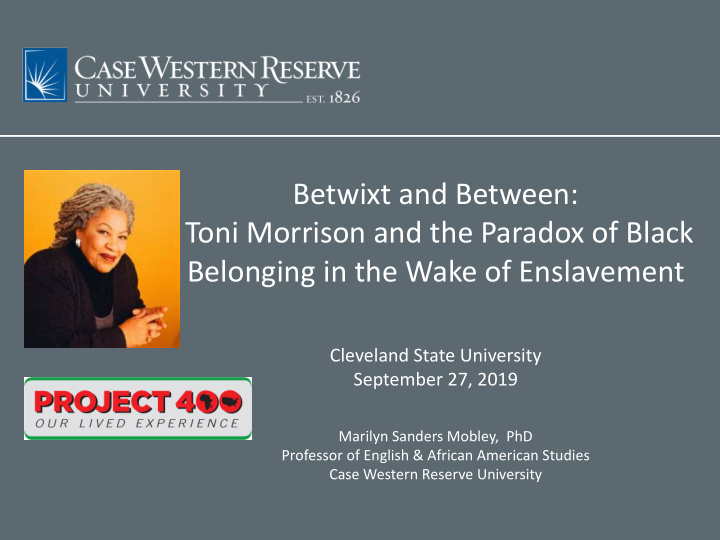



Betwixt and Between: Toni Morrison and the Paradox of Black Belonging in the Wake of Enslavement Cleveland State University September 27, 2019 Marilyn Sanders Mobley, PhD Professor of English & African American Studies Case Western Reserve University
Words from Toni Morrison “Definitions belong to the definers, not the defined.” “Freeing yourself is one thing, claiming ownership of that freed self was another.” -- Beloved, 1987 “…I want to see whether or not race-specific, race-free language is both possible and meaningful in narration. And I want to inhabit, walk around, a site clear of racist detritus; a place where race both matters and is rendered impotent; a place ‘already made for me, both snug and wide open…I want to imagine not the threat of freedom…but the concrete thrill of borderlessness—a kind of out of doors safety where ‘a sleepless woman could…walk out the yard and on down the road..[and]…Nothing for miles around thought she was prey.” -- “Home,” 1998 “We die. That may be the meaning of life. But we do language. That may be the measure of our lives.” -- The Nobel Lecture, 1993 “The function of freedom is to free someone else.”—Barnard College, 1979
Benefits of a Social Justice Reading A social justice reading of Toni Morrison deepens our reading of the meanings of house, home, and belonging in the wake of enslavement in her work and in our lived lives • The Bluest Eye • Beloved • Home These texts also offer an opportunity to understand how intersectionality deepens notions of race, gender, and class that marginalize, minimize, and devalue women and people of color and that consequently undermine communities by creating structural, institutional and systemic inequalities
Other Ways of Reading Toni Morrison • Through the lens of literary/narrative studies • Through the lens of African American/cultural studies • Through the lens of spatial humanities • Through the lens of social justice
Both/And Thinking: Discursive Mediation Du Boisian Double-Consciousness as a Gift “gifted with second-sight in this American world…this double-consciousness, this sense of always looking at one’s self through the eyes of others…” • Race matters AND does not matter • Narrative poetics AND cultural politics • Social justice AND the freedom to create “This then, is the end of his striving: to be a co-worker in the kingdom of culture.” ”Here we have brought our three gifts and mingled them with yours: a gift of story and song… and the gift of sweat and brawn and the gift of the Spirit.”
The Bluest Eye • The cultural work of Toni Morrison’s first novel • The role of the primer in American education • Notions of house, home and community • The intersection of race, gender, class (poverty) • Deconstructions/reconstructions of identity in the face of oppression • The role of scapegoating in communities
Beloved • The cultural work of Beloved • Structuring narrative through memory, black interior lives • Black women’s bodies as the site of production and reproduction • Enslaved bodies and construction of community to create a sense of belonging • Reflecting on “domestic tranquility” and signifying on the present
Home • Telling the story of the aftermath of war • The irony of the return home from Korea and no sense of belonging in America • The critique of racism at home and beyond • Love in the context of oppression • Rethinking pleasure and belonging
The Social Justice Work of Creating Spaces for the Reader “ The classroom remains the most radical space of possibility in the academy…” --bell hooks, Teaching to Transgress, 1994 “The best art is political and you ought to be able to make it unquestionably political and irrevocably beautiful at the same time.” --Toni Morrison, in Black Women Writers at Work, 1984
Works Cited Bhabha, Homi K. The Location of Culture. New York: Routledge, 1994. Du Bois, W.E.B. Souls of Black Folk. New York: Vintage, 1903, 1990. Hooks, bell. Teaching to Transgress: Education as the Practice of Freedom. New York: Routledge, 1994. Mobley, Marilyn Sanders. Folk Roots and Mythic Wings in Sarah Orne Jewett and Toni Morrison: The Cultural Function of Narrative. Baton Rouge: LSU Press, 1991. ___________. “Toni Morrison’s Beloved : The Scandal that Disturbed Domestic Tranquility.” In Scandalous Fictions: The Twentieth-Century Novel in the Public Sphere. Jago Morrison and Susan Watkins, eds. New York: Palgrave, 2006. Morrison, Toni. Beloved. New York: Knopf, 1987. ____________. The Bluest Eye. Random House, 1970
Works Cited (cont’d) ____________. The Nobel Lecture, 1993. ____________. Home. New York: Knopf, 2012. ____________. “Home.” In The House That Race Built: Original Essays by Toni Morrison, Angela Y. Davis, Cornel West, and Others on Black Americans and Politics in America Today. Wahneema Lubiano, ed. New York: Vintage, 1998.
Thank You!
Recommend
More recommend